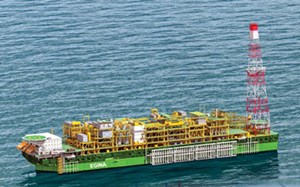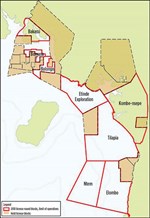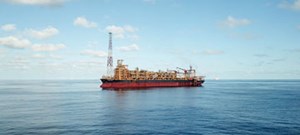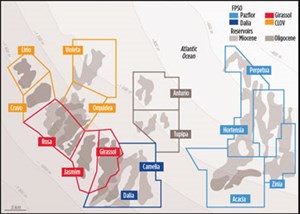Intending to be a global supplier, the region endures output disruptions
Despite ongoing conflict throughout West Africa, the region’s energy sector continues to make progress toward becoming a leading global oil and gas supplier. According to GlobalData, nearly $194 billion will be spent on African oil and gas fields between 2018 and 2025.
NIGERIA
Despite its position as the “Giant of Africa,” in terms of population and economy, Nigeria has struggled for years to resist the threat from militant groups. Because Nigeria is Africa’s top oil producer, militants see oilfield installations as a prime target. In 2016, continual assaults resulted in the lowest output that the country had seen in over three decades.

Last July, suspected Boko Haram militants ambushed a group of geological surveyors in Borno state, in northeastern Nigeria. The attack resulted in the death of numerous Nigerian soldiers—who were acting as security escorts for the exploration team—as well as the kidnapping of several staff members from the University of Maiduguri’s geology department. Militants are progressively getting bolder in their attacks, as the July 2017 strike took place in what was considered a low-risk area.
The attacks are impeding the country’s efforts to expand exploration outside the Niger River Delta, in the hope of finding new crude reserves. The geologists had been working for Nigerian National Petroleum Corp. (NNPC) at the time, surveying parts of the Lake Chad basin, which is said to be a key area of operation for Boko Haram. It reportedly was the first attempt to uncover new reserves since exploration ceased in 2014, due to the wave of violence.
Since the election of President Muhammadu Buhari in 2015, Nigeria’s economy has been shrinking, due largely to the decline in oil production. In the southern Niger River Delta, where most of the country’s oil is produced, continued output disruptions have deprived the government of more than $7 billion in revenue.
Last December, the federal government agreed to take $1 billion from an account designated for oil revenue savings to support the country’s war against Boko Haram’s Islamist insurgency. According to the Nigerian government, the expenditure leaves $1.32 billion in the excess crude account, which is where oil income above projected estimates is saved.
For now, however, there is no end in sight for the Nigerian oil industry, as the threat of violence from several militant groups persists. In November, the Niger Delta Avengers issued another warning to the region: “Our operatives are intact and focused, ready to implement instructions,” the statement read. “We can assure you that every oil installation in our region will feel warmth of the wrath.”

The group also issued reported threats to Total’s Egina oil field, which was scheduled for start-up this year. “The water depth poses a challenge for the development of Egina, which is one of the deepest offshore projects ever operated by Total,” said Jean-Michel Guy, executive general manager of the project. The ultra-deepwater field, situated more than 80 mi offshore, has a forecast production capacity of 200,000 bopd. The project expects to see 44 subsea wells drilled, in water depths between 4,593 ft and 5,577 ft. The wells will be connected, via umbilicals and risers, to an FPSO that is designed to hold 2.3 MMbbl of oil, Fig. 1.
A JV, led by Nigeria LNG, made progress on its $12-billion LNG expansion program this year, which is expected to increase the country’s LNG capacity as much as 40%. The company, alongside Saipem, TechnipFMC and Chiyoda Corp., is working to take FID on the project by the end of the year. In early July, engineering and design contracts were signed for construction of a seventh facility on the nation’s Atlantic coast. The expansion plan is part of the country’s efforts to maintain market share and preserve its position as one of the world’s top LNG exporters, as it competes with increasing output from Qatar, Australia and the U.S.
Nigerian oil producer Shoreline Group also anticipates progress in the Niger River Delta this year, as it seeks to boost output significantly. In January, the company announced a $530-million financing deal with Vitol Group that will allow a production increase of between 80,000 bopd and 100,000 bopd this year. Shoreline reportedly was one of several Nigerian producers that bought fields in the Niger River Delta after international companies, including Shell, withdrew amid the ongoing violence. The company, which holds an estimated 1 Bbbl in reserves, had ceased all production for a year, following the February 2016 closure of the Forcados terminal. According to CEO Kola Karim, the company now plans to boost its gas output from 100 MMscfd to about 500 MMscfd.
According to Bloomberg, however, the Federal Republic of Nigeria, overall, was expected to load just 1.8 MMbopd during July. While the output level is in line with the cap that was agreed on by OPEC, the country still faces the possibility of a production drop, due to the threat of militant attacks. “Security in the Niger Delta remains a major concern, with persisting incidents of criminality, kidnapping and vandalism, as well as onshore and offshore piracy,” said Igo Weli, general manager for external relations at Shell’s local unit.
GHANA/IVORY COAST
The government of Ghana signed an agreement with ExxonMobil Corp. in January, granting the company exploration and production rights for the deepwater Cape Three Points Block. The 366,000-acre block, situated 57 mi off Ghana’s coast, is believed to have high resource potential. As operator, with 80% interest, ExxonMobil will carry out exploration activities in the block later this year, including acquisition and analysis of seismic data.
At present, Ghana reportedly has 21 licensed blocks, 14 of which are in ultra-deepwater territory. Tullow Oil, Anadarko Petroleum, Kosmos Energy and CEF (SOC) are among the top operating companies in the region. Ghana’s E&P sector has taken off over the past five years, with eight new discoveries.
Of late, Ghana and Côte d’Ivoire (also known as Ivory Coast) have dealt with numerous maritime border disputes related to regional offshore exploration blocks. In September, Kosmos Energy, which holds a 17% participating interest in the offshore Tano Block, announced that arbitration between the two countries has not affected production at the offshore TEN development. In addition, Kosmos operates one of Ghana’s latest deepwater projects, Mahogany-Teak-Akasa (MTA). The project is in the West Cape Three Points Block and is anticipated to come online this year.
CAMEROON/EQUATORIAL GUINEA
In Cameroon, Victoria Oil & Gas has made significant progress at Logbaba field, in the Douala basin. Last November, the company reported that its La-108 well had successfully reached nearly 9,400 ft, MD, encountering 277 ft of net gas sand in the Upper and Lower Logbaba formations. This was significantly more than the La-107 net sands, and reportedly exceeded pre-drill estimates. The LA-108 concluded a two-well drilling campaign that had begun in November 2016.
By the end of December, initial flow testing was complete. According to the company release, La-108 showed initial gas flowrates up to 15 MMscfd from the lower Logbaba sands, while La-107 tested at a rate of approximately 4 MMscfd. Following evaluation of seismic reprocessing results and completion of the development drilling campaign, the company revised the field’s reserve estimates in June. The field’s proved reserves were revised upward by 29 Bcf, to 69 Bcf. Additionally, its remaining 2P reserves were revised upward by 106 Bcf, to 309 Bcf. VOG Chairman Kevin Foo said, “The results of this reserves update are a major advance to our business in Cameroon. They provide a significant value upgrade to the Logbaba project, and confirm that the field reserves will meet the growing demand in the Douala market for the foreseeable future.”
One of Cameroon’s biggest developments of late, however, is its $1.2-billion Hilli Episeyo LNG project, which started full commercial operation in early June 2018—just three months after first gas was confirmed. The project’s production vessel reportedly is only the second FLNG facility to go onstream worldwide. And, according to Golar LNG, it is the world’s first FLNG vessel to be developed as a conversion project from an LNG carrier. While the project is fairly small, with a production rate of approximately 2.4 million tons per year, it is an important milestone for Cameroon, making it a net gas exporter and the sixth African nation to supply LNG.

“It’s good to see a new African exporter coming into the market,” Trevor Sikorski, head of natural gas and carbon research at Energy Aspects, told Bloomberg. “An obvious market is Europe, particularly when the markets can be a bit stressed.” Cameroon is said to be geographically well-positioned as a supplier to the European market, as cargo can be transported to Britain in just 11 days.
A directive by state firm Société Nationale des Hydrocarbures’ (SNH), to promote Cameroon’s hydrocarbon resources, instigated the launch of a licensing round this year. The licensing round opened eight blocks—Bakassi, Bomana, Bolongo, Etinde, Kombe-Nsepe, Tilapia, Ntem and Elombo—in the resource-rich Rio del Rey basin and the highly prospective Douala/Kribi-Campo basin, Fig. 2.
Just south of Cameroon, in Equatorial Guinea, Ophir Energy and its partners are still working to secure project financing for the Fortuna project in Block R, west of Bioko Island. There have been six commercial discoveries in the block, to date. According to Ophir, it holds 3.7 Tcf of gas resources, with an expected plateau production rate of 330 MMscfd for 30 years. The project will utilize an FLNG vessel, because the gas uncovered in Block R is particularly rich in methane, with no contaminants or heavy hydrocarbons; therefore, it requires minimal topside processing.
GABON/CONGO
Last year, Shell divested its onshore oil and gas assets in Gabon, selling all its interests to Assala Energy for $628 million in November. Assala is now the second-largest oil producer in the Gabonese Republic, operating Rabi, Toucan/Robin, Koula/Damier, Gamba/Ivinga and Bende/M’Bassou/Totou fields. Additionally, the company holds interests in four non-operated fields—Atora, Avocette, Coucal and Tsiengui.
Panoro Energy, another major operator in Gabon, made progress at Tortue field last April. The company reported successful completion of the field’s first development well, DTM-2H, in the offshore Dussafu license. The well was drilled and completed as a horizontal production well in the Dentale D6 reservoir, encountering a long horizontal section of oil-saturated Dentale D6 sandstone. Additionally, the well encountered a gross 121-ft hydrocarbon column, with nearly 92 ft of net pay, in the shallower Gamba and upper Dentale reservoir section.
Subsequently, Panoro drilled its second development well, DTM-3H. The results reportedly were in line with pre-drill expectations, encountering a long horizontal section of oil-saturated Gamba sandstone. Both development wells were suspended, pending the arrival and hook-up of the FPSO. The BW Adolo FPSO then set sail in Singapore, enroute to Tortue field, in early July. Due to arrive in August, the FPSO reportedly is on schedule to deliver first oil during the second half of the year.
With substantial oil and gas reserves, the Republic of Congo (Brazzaville) became OPEC’s newest member in June. Hydrocarbons Minister Jean-Marc Thystère Tchicaya told Bloomberg shortly thereafter that the country plans to boost oil production by as much as 65% this year. The increase in output is largely attributed to the planned start-up of commercial production at Moho North and Banga Kayo, where an additional 140,000 bopd and 50,000 bopd will be produced, respectively.
The country’s increased output aims to alleviate the economic effects of the recent downturn. Moreover, the Ministry of Hydrocarbons is promoting the Congo-Brazzaville License Round Phase 2. “The Republic of Congo will focus on building on the momentum of the License Round Phase 1 in 2016, which saw 30 international companies register to participate. The timetable for the License Round Phase 2 will see the opening of the call for tender in September 2018, followed by a major promotion campaign in Cape Town (South Africa) at Africa Oil Week in November 2018. The closing date for receipt of tender offers in Brazzaville will be June 30, 2019,” Minister Thystère Tchicaya explained in a release.
In a further push to expand E&P, the Democratic Republic of Congo (DRC) reportedly is considering whether to open parts of its Virunga and Salonga National Parks to drillers. However, the parks contain protected areas of tropical rainforest that are home to mountain gorillas, which are classified as an endangered species. Consequently, it is said that the ministry is enlisting members from the presidency, parliament and the government, as well as civil society organizations, to determine whether or not the plan should press on. “The DRC is committed to not carrying out any oil exploration or production in protected areas,” explained Emmanuel Kayumba, chief of staff in Congo’s Oil Ministry. “Even if the commission comes to a conclusion that we can explore or produce oil, we will do it in respect of the laws and regulations in force, whether local or international.”
ANGOLA
According to GlobalData, Angola will account for approximately 23.8% of Africa’s total capex spending between 2018 and 2025. As Africa’s second-largest producer, Angola’s oil production comprises approximately 50% of its gross domestic product and about 92% of its exports. The country presently produces about 1.55 MMbopd, which is down from last year’s average of 1.67 MMbopd. Last December, the nation’s crude production reached a six-month low, which reportedly was a direct cause of field maintenance. However, Angola reportedly is planning a production increase of about 250,000 bopd by 2020.

Sonangol, the sole concessionaire for E&P in Angola, is said to be in talks with oil majors, including ExxonMobil and Equinor, concerning the potential boost. The company’s chairman of the board, Carlos Saturnino, said that Angola is becoming more attractive to international operators, due to more favorable investment terms and improved energy legislation. Accordingly, the country is expected to see an increased production level of no less than 1.63 MMbopd next year.
Officials also have alluded to a possible oil and gas bidding round before 2019. The tender reportedly is for oil blocks in the Namibe basin, off Angola’s southern coast. “It’s about 10 offshore blocks, although there is nothing concrete at the moment,” Petroleum Minister Jose Maria Botelho de Vasconcelos told Bloomberg last August.
The expected production increase is largely ascribed to the planned start-up of Total’s $16-billion Kaombo project. The ultra-deepwater development, situated in Block 32, holds an estimated 660 MMbbl of reserves, spread across six fields. The fields will be connected through 186 mi of subsea pipelines that will produce to two FPSO units, each with a treatment capacity of 115,000 bopd, Fig. 3. According to Total, the fields’ reserves span a diverse system of reservoirs that reach depths down to 6,397 ft. Once online, output is expected to peak at approximately 230,000 bopd, according to IEA.
Earlier this year, Eni reported a ramp-up of production at Ochigufu field, in Angola’s deep offshore Block 15/06. The field is connected to the Sangos production system, which then connects to the N’Goma FPSO, in the block’s West Hub. According to the company, several more start-ups are planned for the block this year, including the UM8 reservoir in the East Hub and the Subsea Boosting System for Mpungi field. Additionally, Angola’s Vandumbu field, also in the West Hub, is expected to start production early next year. Eni said that the planned start-ups will add an additional 30,000 bopd to the block’s overall production, exceeding 170,000 bopd in 2019.

Eni reported more success in Block 15/06 during June 2018, announcing a new oil discovery in the Kalimba exploration prospect. The Kalimba-1 NFW well, about 31 mi southeast of the Armada Olombendo FPSO, was drilled by the West Gemini drillship in a water depth greater than 1,500 ft. The well proved a 75-ft net oil pay of high-quality oil in Upper Miocene sandstones, with excellent petrophysical properties. Eni said that data acquired from the wellsite indicated a production capacity in excess of 5,000 bopd. The discovery is estimated to contain between 230 MMbbl and 300 MMbbl of light oil in place, overall. According to Eni, the oil find is creating more exploration opportunities for the southern portion of Block 15/06 because, until now, it was deemed a predominantly gas-prone area.
In May, Total reported progress in Angola’s Block 17, Fig. 4. FID was taken on the company’s Zinia 2 project, about 93 mi off Angola’s coast. The project is made up of nine wells that will be tied back to the Pazflor FPSO. The wells are in water depths ranging from 1,968 ft to 3,937 ft. According to the company, Zinia 2 is the first of several potential short-cycle developments on the block, intended to unlock its remaining resources through the connection of satellite reservoirs to the existing FPSOs. Total E&P President Arnaud Breuillac said in a statement, “Zinia 2 opens a new chapter in the history of Block 17. This project will allow [us] to extend the profitability of this prolific block, with over 2.6 Bbbl already produced.” ![]()
- Applying ultra-deep LWD resistivity technology successfully in a SAGD operation (May 2019)
- Adoption of wireless intelligent completions advances (May 2019)
- Majors double down as takeaway crunch eases (April 2019)
- What’s new in well logging and formation evaluation (April 2019)
- Qualification of a 20,000-psi subsea BOP: A collaborative approach (February 2019)
- ConocoPhillips’ Greg Leveille sees rapid trajectory of technical advancement continuing (February 2019)


